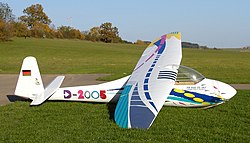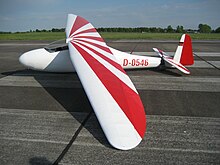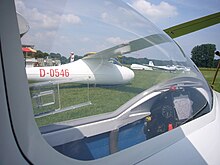Lo 100
| Lo 100 | |
|---|---|

|
|
| Type: | Glider aerobatic |
| Design country: | |
| Manufacturer: | |
| First flight: |
1952 |
The Lo 100 "Zwergreiher" is a wooden aerobatic glider . The design by Alfred Vogt was the first fully aerobatic redesign after the Second World War in Germany. At the end of the 1950s, the license building rights were acquired from "Burgfalke Flugzeugbau" in Burglengenfeld .
history
The Lo 100 goes back to the small sailor (wingspan 10.50 m) developed by Vogt in 1935, Lo 105, which could only be flown in and tested in 1943. As a further development of the Lo 105, the Lo 100 was designed and built in 1952 in 3½ months. The first flight of the prototype took place at the glider pilot's meeting on the Klippeneck in the same year. The Lo 100 was then subjected to a final test in Kufstein . The Lo 150 developed from this in 1953 has a two-part wing with a 15 m span.

Vogt chose the name Lo in honor of his brother Lothar, with whom he had developed the Lo 105. Lothar died in September 1938 as a result of pneumonia that he suffered from gliding in winter.
construction
The Lo 100 is a single-seat, cantilever high-decker made entirely of wood. In order to cope with the stresses of aerobatics, the one-piece wing was given a continuous main spar made of beech plywood (TBu 20) and a plywood-clad torsion nose. The flaps can be extended up to 45 ° as a landing aid. When approaching for landing, the aircraft must be brought to the ground in a side glide (slip), as it has no spoilers .
The fuselage has a wooden shell construction with an oval cross-section and has a bow and side wall coupling for take-off in aircraft tow or on the winch . The self-supporting normal tail unit is also constructed in wood. The wing is plywood-planked in front of the spar and covered with fabric behind it. The chassis consists of a concealed single wheel with a central runner. It soon became apparent that the hull of the Lo 100 was no longer able to cope with the growing demands of glider aerobatics. Therefore, the additional reinforcement strips were glued onto the outside of the rear fuselage. Eichelsdörfer GmbH in Bamberg took over the prototype support .
Technical specifications
| Parameter | Data |
|---|---|
| span | 10.00 m |
| Max. Wing loading | 23.8 daN / m² (kg / m²) |
| Wing area | 10.90 m² |
| Elongation | 9.17 |
| V and arrow shape | 0 ° |
| profile | Clark-Y , thickness 11.7% |
| Height above everything | 1.38 m |
| length | 6.21 m |
| Top speed | 290 km / h |
| Stall speed | 40-50 km / h |
| Preparation mass | 160 kg |
| Max. Takeoff mass | 265 kg |
| Max. Takeoff mass (aerobatics) | 245 kg |
| Slightest sinking | 0.80 m / s at 72 km / h |
| Best glide | approx. 25 at 85 km / h |
literature
- Dietmar Geistmann: The gliders in Germany. ISBN 3-87943-618-5
- Georg Brütting : The most famous gliders. ISBN 3-613-02296-6
- Martin Simons: Gliders Volume 2 1945-1965. EQIP Verlag, Königswinter near Bonn
- Peter Mallinson, Mike Wollard: Manual of glider aerobatics. EQIP Verlag, Königswinter near Bonn
- Eric Müller: Upside Down - the fascination and technology of aerobatics. ISBN 3-517-01212-2
- Karlheinz Kens: Airplane types - type book of international aviation . 4th edition. Carl Lange Verlag, Duisburg 1963.
Web links
- Flight and operations manual for the Lo-100 glider type. (PDF) D-0546, work number 204. Archived from the original on March 5, 2007 ; Retrieved October 5, 2017 (32 pages).
- Glider Museum
- Website of the aerobatic team in Franconia


